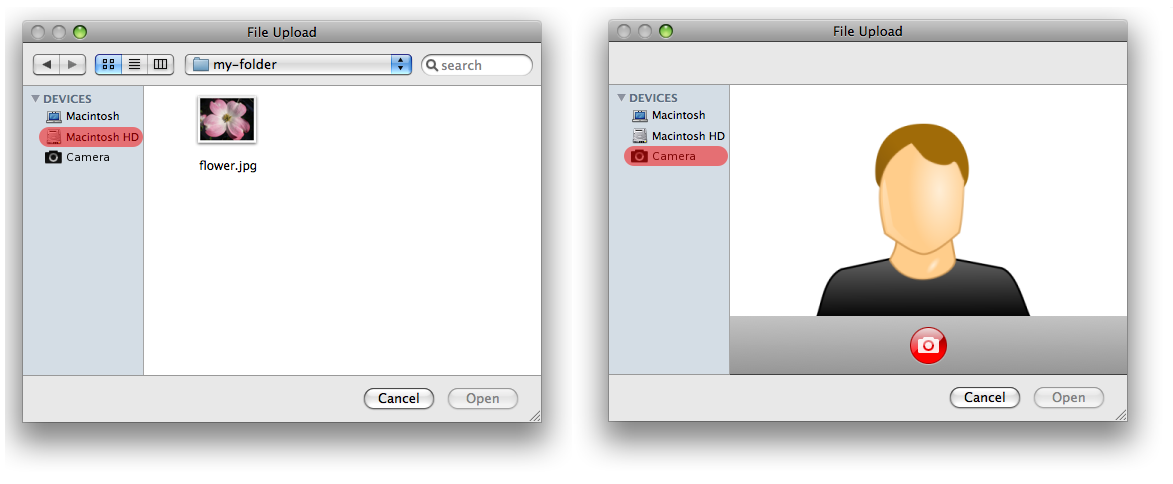
HTML Media Capture
W3C Last Call Working Draft 26 March 2013
- This version:
- http://www.w3.org/TR/2013/WD-html-media-capture-20130326/
- Latest published version:
- http://www.w3.org/TR/html-media-capture/
- Latest editor's draft:
- http://dev.w3.org/2009/dap/camera/
- Previous version:
- http://www.w3.org/TR/2012/WD-html-media-capture-20121213/
- Editors:
- Anssi Kostiainen, Nokia
- Ilkka Oksanen, Nokia (until May 10, 2012)
- Dominique Hazaël-Massieux, W3C (until May 10, 2012)
Copyright ©
2013
W3C®
(MIT,
ERCIM,
Keio, Beihang), All Rights Reserved.
W3C liability,
trademark and
document use rules apply.
Abstract
The HTML Media Capture specification defines an HTML form
extension that facilitates user access to a device's media capture
mechanism, such as a camera, or microphone, from within a file upload
control.
Status of This Document
This section describes the status of this document at the time of its publication. Other
documents may supersede this document. A list of current W3C publications and the latest revision
of this technical report can be found in the W3C technical reports
index at http://www.w3.org/TR/.
This is a second Last Call of HTML Media Capture.
The
following changes (detailed
change log,
redline) have been made since the
W3C Working Draft 12 July 2012:
-
Changed the type of the
capture attribute from
an enumerated attribute into a boolean attribute.
-
Clarified use cases and examples.
This document was published by the Device APIs Working Group as a Last Call Working Draft.
This document is intended to become a W3C Recommendation.
If you wish to make comments regarding this document, please send them to
public-device-apis@w3.org
(subscribe,
archives).
The Last Call period ends 19 April 2013.
All comments are welcome.
Publication as a Last Call Working Draft does not imply endorsement by the W3C Membership.
This is a draft document and may be updated, replaced or obsoleted by other documents at
any time. It is inappropriate to cite this document as other than work in progress.
This is a Last Call Working Draft and thus the Working Group has determined that this document has satisfied the
relevant technical requirements and is sufficiently stable to advance through the Technical Recommendation process.
This document was produced by a group operating under the
5 February 2004 W3C Patent Policy.
W3C maintains a public list of any patent disclosures
made in connection with the deliverables of the group; that page also includes instructions for
disclosing a patent. An individual who has actual knowledge of a patent which the individual believes contains
Essential Claim(s) must disclose the
information in accordance with section
6 of the W3C Patent Policy.
4. Security and privacy considerations
The user agent SHOULD NOT enable any device for media capture, such as
a microphone or camera, until a user interaction giving implicit
consent is completed. A user agent SHOULD also provide an indication
when such an input device is enabled and make it possible to terminate
such capture. Similarly, the user agent SHOULD allow the user:
-
to select the exact media capture device to be used if there exists
multiple devices of the same type (e.g. a front-facing camera in
addition to a primary camera).
-
to disable sound capture when in the video capture mode.
This specification builds upon the security and privacy protections
provided by the <input type="file"> [HTML5] and
the [FILE-API] specifications; in particular, it is expected that
any offer to start capturing content from the user’s device would
require a specific user interaction on an HTML element that is entirely
controlled by the user agent.
Implementors SHOULD take care of additional leakage of privacy-sensitive
data from captured media. For instance, embedding the user’s location in
a captured media metadata (e.g. EXIF) might transmit more private data
than the user might be expecting.
